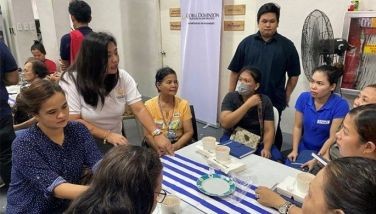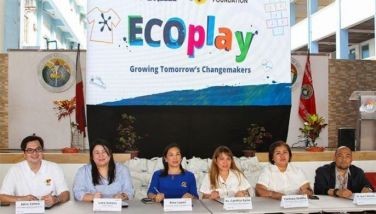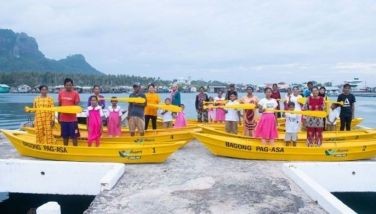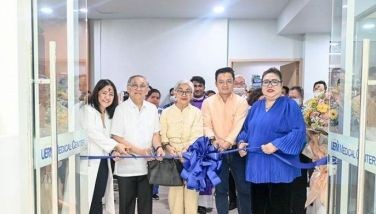And then therewaslight
January 30, 2005 | 12:00am
HAMSAINI KIPLI WAS ALREADY IN FOURTH GRADE BUT DIDN’T KNOW HOW TO READ AND couldn’t spell his father’s name. Ussam desperately wanted to help his boy learn but he could only tutor him at night when he returned from the great provider that is the sea. But he couldn’t do that because there was no light–his barangay didn’t have electricity.
They may have so much less of the luxuries of modern living taken for granted by city dwellers, but people like Ussam are blessed nonetheless. For Ussam and many others in the south, such blessedness comes in a project called "AMORE."
Amore is love in Italian and indeed, the heart of the Amore project is the genuine ardor of people wanting to help our underprivileged Muslim brethren by literally making them see the light– through renewable energy like solar and hydro power. Nature’s power working for man, not against him.
AMORE, or the Alliance for Mindanao Off-grid Renewable Energy Program, is a rural electrification project funded by the United States Agency for International Development (usaid) and being implemented by Winrock International, a US-based international non-profit organization in partnership with the Philippines’ Department of Energy (DOE), the Autonomous Region in Muslim Mindanao (ARMM), and independent power producer Mirant Philippines.
The AMORE program is more than just bringing light to homes. More importantly it promotes sustainable progress and peace in conflict-ridden Mindanao by raising the quality of life in unelectrified communities. And when the job is done, AMORE wants nothing more than to have empowered their beneficiaries to pursue long-term economic and social development that would hopefully lead to long-term peace in the region.
According to the AMORE website (www.amore.org.ph), of the Philippines’ close to 42,000 barangays, around 3,700 were still unelectrified as of June 2004, most of them in far-off rural areas which cannot be connected to the national grid due to either geographical limitations or economic non-viability. About half of these unelectrified barangays are in Mindanao.
To date, a total of 5,302 households, 188 community centers and 376 streets in 205 barangays have been lighted up by AMORE in the ARMM provinces of Tawi-Tawi, Basilan, Sulu and Maguindanao, as well as in Sultan Kudarat, Zamboanga Sibugay, Zamboanga City and Davao. AMORE says "electricity is key to human activity" that leads to productivity, especially among the dynamic youth of today.
School doesn’t stop when the bell rings. A crucial part of studying is done at home when parents huddle with their kids to review homework. So when light found its way into Ussam’s home in barangay North Taipan Bohe in Sapa-Sapa, Tawi-Tawi, he lost no time helping in his children’s learning process. Ussam reached college but poverty forced him to quit and so, he perseveres to send his children to school, a most important step for the young. Hamsaini is now in fifth grade, one of the top three students in his class in the capital of Bongao.
Dreaming of becoming a teacher someday, Norminy Arik, a first year high school student, does not mind the commute of an hour by boat. She diligently studied at night, straining her eyes under the poor illumination of a kerosene lamp. But since AMORE installed a solar-powered fluorescent light with a voltage of 12-VDC in the Arik household, Nominy now studies better and longer.
A future of hope for the next generation was what Carsoma Abunawas had in mind, even as she realized that being a Muslim woman meant she could not leadership positions. "Most people are not aware of how difficult it is for us Muslim women to take on leadership responsibilities in our communities," Carsoma confesses. "Most of the time, the women lack confidence and are afraid, or just too busy taking care of their family and households."
This did not deter her from taking on the challenge of heading the local AMORE project in Barangay Tumalutab in Zamboanga City. "I really wanted development not only for my family and myself, but also for my community." She started attending Amore-sponsored seminars and training.
"At first, a lot of people in my community thought I was stupid. But now, they have seen the lights which are brighter than the kerosene wick lamps we were using before," Carsoma says. "Those who have small children are also happy because now there is light to help them attend to their babies when they wake up in the middle of the night."
These are just some of the "little success stories" brought to the fore because of the AMORE project. Put them all together and one sees the big picture showing both an encouraging side as well as the downside of living in a poor nation where basic services often do not reach the remote nooks of over seven thousand islands.
A key component of AMORE’s electrification strategy is providing renewable energy, a source of power that is environment-friendly. It is "constantly replenished, is generally inexhaustible, or is continuously re-supplied," AMORE says. Among the renewable energy sources are solar, wind, geothermal, and biomass power.
By and large, the AMORE program uses solar energy to charge batteries that can be used by the residents to light up their homes. Only around P50 is spent on recharging batteries a month, definitely cheaper than P165 a month for using kerosene lamps.
Micro-hydro system, which will be implemented in the second phase of the AMORE program starting next month until Sept. 2009, uses moving water sources to produce electricity and power machines being used for livelihood. This system can light more households than solar energy–150 homes as against 30, respectively.
AMORE chooses its beneficiaries from a list provided by the DOE on barangays not yet electrified and looks at its capability to organize and sustain the gains of the program. It looks for communities where consumers ideally can pay back 25 percent of the cost of system; money which will go to the Barangay Renewable Energy and Community Development Association or BRECDA, organized to operate, maintain and productively use the energy systems to power their own socio-economic development. So far, a total of 198 brecdas have been organized.
Collection, however, doesn’t come easy as the beneficiaries are among the poorest of the poor in the country. But nothing is impossible for these rejuvenated souls: Barangay Tumalutab, for example, has so far collected P110,000 seed money which they will use to buy additional solar-powered systems.
AMORE acknowledges the importance of community involvement. Dialogues with the people are held as well as training to develop in them a "sense of ownership" of the systems. AMORE also works with multisectoral partners to ensure the success of the program on all fronts. And even after phase 1 of the program has ended (targeted by March), AMORE ensures that beneficiaries will be self-sustaining in the operation, maintenance, usage and expansion of the renewable energy systems installed in their communities.
AMORE will organize the BRECDAs into a federation, which can become its partners in training other communities to operate and maintain the energy systems. The AMORE project costs nearly $8 million funded principally by the USAID for community organization, but resources also come from other donors for systems procurement and livelihood and social services.
With many electrification projects based on renewable energy having come and gone in Mindanao, locals were initially skeptical about yet another initiative.
Gerry Hadjin, like many others in his community, had felt neglected by the government and lost all hope that development would come their way. Gerry lives in Barangay Cabengbeng in Sumisip town in Basilan, another hotbed of armed hostilities as military forces continue to flush out members of the Abu Sayyaf terror group. Before his village benefited from the rural electrification project, nights were especially hard as his family had to use a palipaan, the local term for a kerosene lamp made of either glass bottles or tin cans. Its dim, flickering light and the thick smoke it emits discouraged his children from studying. The women in the village were left with no choice but to stop their mat-weaving.
But then the lights came and Gerry’s children, overwhelmed and awed by the solar-powered glow, shed tears of joy. Gerry saw too the light of hope, which restored his faith in a bright future for his family and his community. Now, he is chairman of his village’s BRECDA.
The AMORE program has gone a long way since it began just three years back. On top of having provided the light of hope, it reminds the less fortunate that they have a choice and the power to make things happen by sustaining efforts for the betterment of their communities. All in the name of peace and progress.
They may have so much less of the luxuries of modern living taken for granted by city dwellers, but people like Ussam are blessed nonetheless. For Ussam and many others in the south, such blessedness comes in a project called "AMORE."
Amore is love in Italian and indeed, the heart of the Amore project is the genuine ardor of people wanting to help our underprivileged Muslim brethren by literally making them see the light– through renewable energy like solar and hydro power. Nature’s power working for man, not against him.
AMORE, or the Alliance for Mindanao Off-grid Renewable Energy Program, is a rural electrification project funded by the United States Agency for International Development (usaid) and being implemented by Winrock International, a US-based international non-profit organization in partnership with the Philippines’ Department of Energy (DOE), the Autonomous Region in Muslim Mindanao (ARMM), and independent power producer Mirant Philippines.
The AMORE program is more than just bringing light to homes. More importantly it promotes sustainable progress and peace in conflict-ridden Mindanao by raising the quality of life in unelectrified communities. And when the job is done, AMORE wants nothing more than to have empowered their beneficiaries to pursue long-term economic and social development that would hopefully lead to long-term peace in the region.
According to the AMORE website (www.amore.org.ph), of the Philippines’ close to 42,000 barangays, around 3,700 were still unelectrified as of June 2004, most of them in far-off rural areas which cannot be connected to the national grid due to either geographical limitations or economic non-viability. About half of these unelectrified barangays are in Mindanao.
To date, a total of 5,302 households, 188 community centers and 376 streets in 205 barangays have been lighted up by AMORE in the ARMM provinces of Tawi-Tawi, Basilan, Sulu and Maguindanao, as well as in Sultan Kudarat, Zamboanga Sibugay, Zamboanga City and Davao. AMORE says "electricity is key to human activity" that leads to productivity, especially among the dynamic youth of today.
School doesn’t stop when the bell rings. A crucial part of studying is done at home when parents huddle with their kids to review homework. So when light found its way into Ussam’s home in barangay North Taipan Bohe in Sapa-Sapa, Tawi-Tawi, he lost no time helping in his children’s learning process. Ussam reached college but poverty forced him to quit and so, he perseveres to send his children to school, a most important step for the young. Hamsaini is now in fifth grade, one of the top three students in his class in the capital of Bongao.
Dreaming of becoming a teacher someday, Norminy Arik, a first year high school student, does not mind the commute of an hour by boat. She diligently studied at night, straining her eyes under the poor illumination of a kerosene lamp. But since AMORE installed a solar-powered fluorescent light with a voltage of 12-VDC in the Arik household, Nominy now studies better and longer.
A future of hope for the next generation was what Carsoma Abunawas had in mind, even as she realized that being a Muslim woman meant she could not leadership positions. "Most people are not aware of how difficult it is for us Muslim women to take on leadership responsibilities in our communities," Carsoma confesses. "Most of the time, the women lack confidence and are afraid, or just too busy taking care of their family and households."
This did not deter her from taking on the challenge of heading the local AMORE project in Barangay Tumalutab in Zamboanga City. "I really wanted development not only for my family and myself, but also for my community." She started attending Amore-sponsored seminars and training.
"At first, a lot of people in my community thought I was stupid. But now, they have seen the lights which are brighter than the kerosene wick lamps we were using before," Carsoma says. "Those who have small children are also happy because now there is light to help them attend to their babies when they wake up in the middle of the night."
These are just some of the "little success stories" brought to the fore because of the AMORE project. Put them all together and one sees the big picture showing both an encouraging side as well as the downside of living in a poor nation where basic services often do not reach the remote nooks of over seven thousand islands.
A key component of AMORE’s electrification strategy is providing renewable energy, a source of power that is environment-friendly. It is "constantly replenished, is generally inexhaustible, or is continuously re-supplied," AMORE says. Among the renewable energy sources are solar, wind, geothermal, and biomass power.
By and large, the AMORE program uses solar energy to charge batteries that can be used by the residents to light up their homes. Only around P50 is spent on recharging batteries a month, definitely cheaper than P165 a month for using kerosene lamps.
Micro-hydro system, which will be implemented in the second phase of the AMORE program starting next month until Sept. 2009, uses moving water sources to produce electricity and power machines being used for livelihood. This system can light more households than solar energy–150 homes as against 30, respectively.
AMORE chooses its beneficiaries from a list provided by the DOE on barangays not yet electrified and looks at its capability to organize and sustain the gains of the program. It looks for communities where consumers ideally can pay back 25 percent of the cost of system; money which will go to the Barangay Renewable Energy and Community Development Association or BRECDA, organized to operate, maintain and productively use the energy systems to power their own socio-economic development. So far, a total of 198 brecdas have been organized.
Collection, however, doesn’t come easy as the beneficiaries are among the poorest of the poor in the country. But nothing is impossible for these rejuvenated souls: Barangay Tumalutab, for example, has so far collected P110,000 seed money which they will use to buy additional solar-powered systems.
AMORE acknowledges the importance of community involvement. Dialogues with the people are held as well as training to develop in them a "sense of ownership" of the systems. AMORE also works with multisectoral partners to ensure the success of the program on all fronts. And even after phase 1 of the program has ended (targeted by March), AMORE ensures that beneficiaries will be self-sustaining in the operation, maintenance, usage and expansion of the renewable energy systems installed in their communities.
AMORE will organize the BRECDAs into a federation, which can become its partners in training other communities to operate and maintain the energy systems. The AMORE project costs nearly $8 million funded principally by the USAID for community organization, but resources also come from other donors for systems procurement and livelihood and social services.
With many electrification projects based on renewable energy having come and gone in Mindanao, locals were initially skeptical about yet another initiative.
Gerry Hadjin, like many others in his community, had felt neglected by the government and lost all hope that development would come their way. Gerry lives in Barangay Cabengbeng in Sumisip town in Basilan, another hotbed of armed hostilities as military forces continue to flush out members of the Abu Sayyaf terror group. Before his village benefited from the rural electrification project, nights were especially hard as his family had to use a palipaan, the local term for a kerosene lamp made of either glass bottles or tin cans. Its dim, flickering light and the thick smoke it emits discouraged his children from studying. The women in the village were left with no choice but to stop their mat-weaving.
But then the lights came and Gerry’s children, overwhelmed and awed by the solar-powered glow, shed tears of joy. Gerry saw too the light of hope, which restored his faith in a bright future for his family and his community. Now, he is chairman of his village’s BRECDA.
The AMORE program has gone a long way since it began just three years back. On top of having provided the light of hope, it reminds the less fortunate that they have a choice and the power to make things happen by sustaining efforts for the betterment of their communities. All in the name of peace and progress.
BrandSpace Articles
<
>
- Latest
- Trending
Trending
Latest
Trending
Latest
Recommended


















